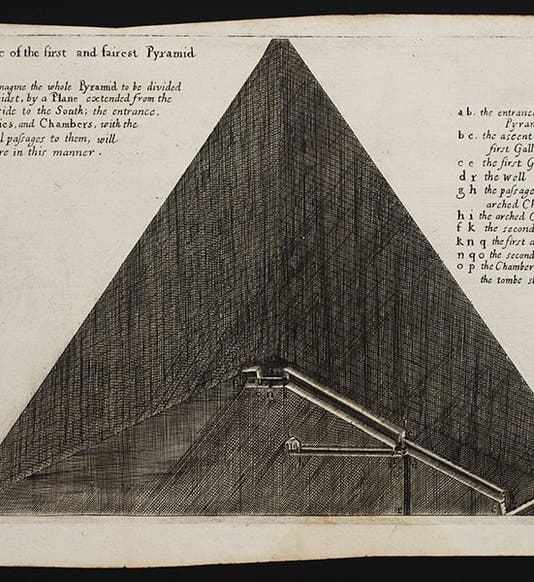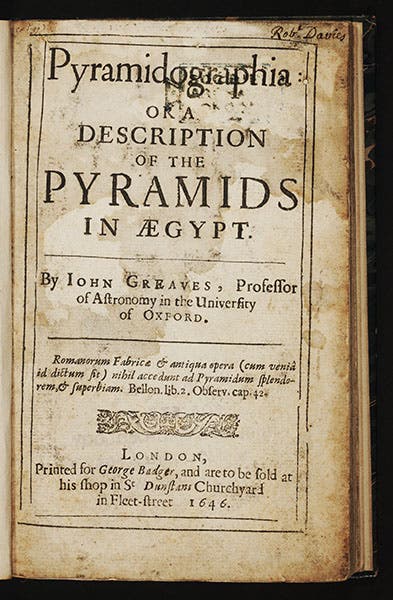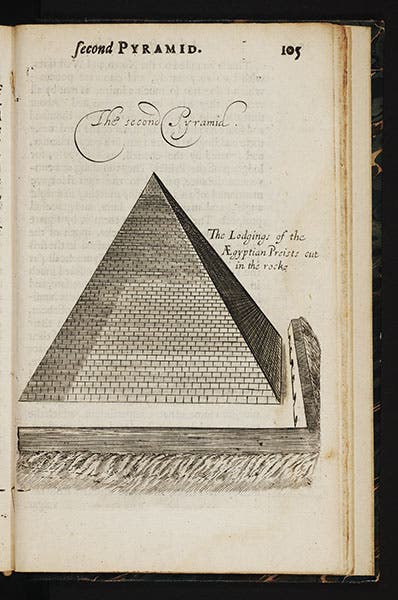Scientist of the Day - John Greaves
John Greaves, an English astronomer, died Oct. 8, 1652, at the age of about 50; his birthdate is unknown. Greaves was Gresham Professor Geometry in London, a prestigious position in 17th-century England. He was also a collector of instruments and coins, and an inveterate traveler. In 1837, he journeyed to the middle east, to measure the latitude of several sites used by ancient astronomers, and he make a special trip to Alexandria, since that was the home base for the Greek astronomer Ptolemy of Alexandria. From there, it was not far to the pyramids, where he made a detailed study of the site, making many measurements, which makes him a Pyramidologist - someone who wants to determine the exact dimensions of the pyramids. However, unlike the pyramidologists of the 19th century, who believed that all the dimensions of the universe were somehow encoded in the pyramids, if we could just figure out the code, Greaves had a much less lofty goal: he simply wanted to measure with great accuracy some objects that had been around for some 3000 years and had hardly changed in that time.
Greaves’ goal was to provide some universal standards of weights and measures. When he measured the length of certain stones in the pyramids to be so many feet, inches, and fractions of inches, he wasn't trying to define the length of some sacred ancient cubit. He was rather attempting to define the modern English foot and inch, so that if something happened to the English standards, we could go back to Egypt and redefine them. This sounds like an odd project, but in the 17th century, Egypt and the pyramids were the epitome of timelessness; other monuments had come and gone, but the pyramids seemed here to stay. What better place to base your standards of measures than among those eternal stones.
In 1646, Greaves published his Pyramidographia, or, A description of the pyramids in Aegypt, which we have in our History of Science Collection. The images here are all from that work, and diagram the Great Pyramid, inside (first image) and out (third image), the second pyramid, and the title page. We also have two early editions of his attempt to codify ancient units of measurment, A discourse of the Romane foot, and denarius: from whence, as from two principles, the measures and weights, used by the Ancients, may be deduced (1647).
Interestingly, when Greaves returned from his travels, his Gresham professorship was taken away from him, as he was not fulfilling his duties. Fortunately, he soon picked up the Savilian professorship in astronomy at Oxford, which he held until his premature death. Several of his instruments ended up in the Museum of the History of Science at Oxford, where you may see them today. We show here an astrolabe that Greaves supposedly took with him on his trip to the Levant (fifth image).
Dr. William B. Ashworth, Jr., Consultant for the History of Science, Linda Hall Library and Associate Professor, Department of History, University of Missouri-Kansas City. Comments or corrections are welcome; please direct to ashworthw@umkc.edu.










